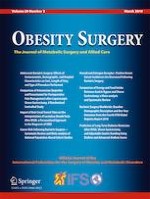Erschienen in:

07.12.2018 | Original Contribution
Polyneuropathy in Severely Obese Women Without Diabetes: Prevalence and Associated Factors
verfasst von:
Lisiane Stefani Dias, Otto Henrique Nienov, Fernanda Dapper Machado, Camila Perlin Ramos, Daiane Rodrigues, Rodrigo Koprovsky Menguer, Helena Schmid
Erschienen in:
Obesity Surgery
|
Ausgabe 3/2019
Einloggen, um Zugang zu erhalten
Abstract
Background
Obesity and its complications are prevalent in women and increase with age. Polyneuropathy (PNP) is a complication of obesity and bariatric surgery (BS). In subjects with severe (grades II and III) obesity and without DM who are candidates for BS, the prevalence of PNP and associated conditions are not well characterized. The aim of this study was to evaluate the prevalence of PNP in severely obese (SO) women without DM or common nutritional deficiencies in order to determine factors associated with the presence of PNP.
Methods
A cross-sectional study was performed on 450 SO women. They were evaluated with the Michigan Neuropathy Screening Instrument, a Sleep Apnea Questionnaire, and the short form of the International Physical Activity Questionnaire. Data on blood pressure, body mass index, waist circumference, serum glucose, glycated hemoglobin, LDL and HDL cholesterol, triglycerides, vitamin B12, and postmenopausal (PM) status were also collected. Patients with DM and other common causes of PNP were excluded. To evaluate which variables were independently associated with PNP (dependent variable), Poisson regression models were used.
Results
The prevalence of PNP was 11.6%. In univariate analysis, PNP was associated with age, PM status, and diagnosis of systemic arterial hypertension (p < 0.001, p < 0.001, and p = 0.016, respectively), and there was a trend toward an association with sleep apnea risk (p = 0.101). In multivariate analysis, PM status (PR = 2.836, 95% CI 1.735–4.636, p = 0.001) and age (PR = 1.0511, 95% CI 1.031–1.071, p = 0.001) were independently associated with PNP diagnosis in two different models.
Conclusion
Even prior to BS, PNP is highly prevalent and is associated with PM status and age in SO women without diabetes.